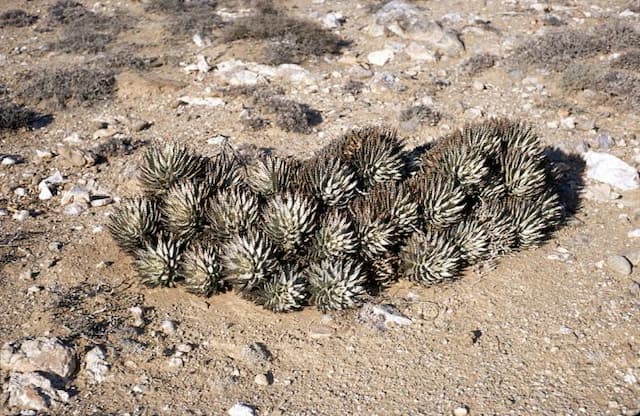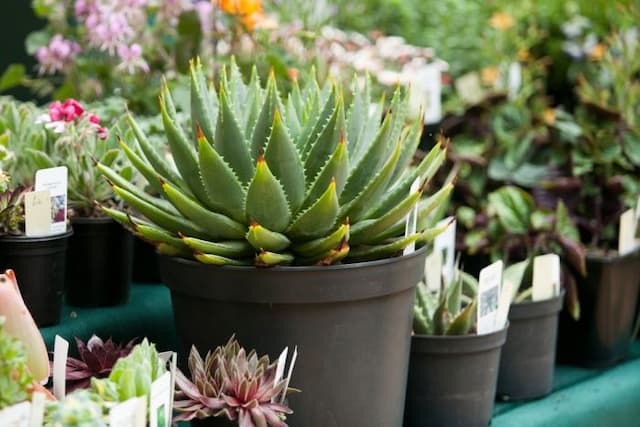Red hot poker Kniphofia 'Dorset Sentry'

ABOUT
Kniphofia 'Dorset Sentry', commonly known as Red Hot Poker, torch lily or poker plant, is a perennial plant celebrated for its distinct and remarkable flower spikes. The plant features sturdy, upright stems that rise above strap-shaped, green leaves which are slightly arching and give it a grass-like appearance. The striking flowers bloom in clusters on the upper part of the stem, with each flower spike characterized by a gradation of color. The blossoms usually start with a warm hue of yellow at the top, transitioning to richer shades of orange and red towards the base, creating a fiery effect reminiscent of a glowing torch. When in bloom, these eye-catching flower spikes can create a bold statement in the garden, attracting hummingbirds and butterflies. The foliage remains attractive even when the plant is not in flower, providing a lush backdrop for other plants in the landscape.
About this plant
 Names
NamesFamily
Asphodelaceae
Synonyms
Red Hot Poker, Torch Lily, Tritoma
Common names
Kniphofia 'Dorset Sentry'
 Toxicity
ToxicityTo humans
The Kniphofia 'Dorset Sentry', commonly known as the Red Hot Poker, does not have widespread recognition for being poisonous to humans. However, it is always prudent to exercise caution and avoid ingesting plants that are not typically recognized as food, due to the risk of individual allergic reactions or gastrointestinal distress. Ingesting any part of the Red Hot Poker has not been commonly associated with serious poisoning in humans, but it may cause mild discomfort, irritation, or an upset stomach if consumed.
To pets
The Red Hot Poker is generally not considered highly toxic to pets, but it may cause mild gastrointestinal upset if ingested. As with many ornamental garden plants, it would be best to prevent your pets from consuming parts of the Red Hot Poker. Symptoms could potentially include vomiting or diarrhea, and if you suspect that your pet has ingested a significant amount, it is advisable to consult with a veterinarian.
 Characteristics
CharacteristicsLife cycle
Perennials
Foliage type
Evergreen
Color of leaves
Green
Flower color
Mixed
Height
3-4 feet (0.91-1.22 meters)
Spread
1-2 feet (0.30-0.61 meters)
Plant type
Herb
Hardiness zones
5-9
Native area
South Africa
Benefits
 General Benefits
General Benefits- Attracts Pollinators: Kniphofia 'Dorset Sentry', commonly known as Red Hot Poker, attracts bees, butterflies, and hummingbirds, helping to pollinate the garden.
- Drought Tolerance: Once established, they are quite drought-tolerant, making them ideal for xeriscaping or low-water gardens.
- Low Maintenance: Red Hot Poker plants are generally low-maintenance, requiring minimal care once they are settled in their location.
- Long Blooming: They have a long blooming period, which can extend from late spring to early fall, providing prolonged visual interest.
- Unique Appearance: Their striking flower spikes offer a unique appearance that can create a focal point or add an exotic touch to a garden space.
- Cold Hardy: They are hardy in many climates and can withstand cold temperatures, making them suitable for a variety of growing zones.
- Diverse Landscaping Use: They can be used in perennial borders, as accent plants, or in mass plantings for a dramatic effect.
- Deer Resistant: The plants are known to be deer resistant, which is especially beneficial in areas where deer browsing can be a problem.
 Medical Properties
Medical PropertiesThis plant is not used for medical purposes.
 Air-purifying Qualities
Air-purifying QualitiesThis plant is not specifically known for air purifying qualities.
 Other Uses
Other Uses- Drawing Wildlife: Red hot pokers can be used to attract hummingbirds and butterflies to gardens due to their vividly colored and nectar-rich flowers.
- Themed Gardens: The striking flowers and South African origins make red hot pokers excellent choices for African-themed garden designs or hot-colored borders.
- Dramatic Cut Flowers: The long-lasting blooms can be cut and used in bold and dramatic floral arrangements to add height and color.
- Architectural Focal Point: Due to their height and distinctive shape, red hot pokers serve as a strong architectural focal point in garden designs.
- Photogenic Subject: The unique torch-like flowers of red hot pokers make them a popular subject for garden photography enthusiasts.
- Erosion Control: The grass-like foliage and clumping growth habit can help stabilize soil and prevent erosion on slopes.
- Teaching Tool: Red hot pokers can be used as educational specimens to discuss plant adaptation and pollinator attraction strategies in biology classes.
- Garden Art Imitation: Stately and sculptural, the red hot poker can mimic garden art pieces, providing a natural twist to garden sculptures.
- Texture Contrast: In garden compositions, their spiky texture can be used to contrast against softer, billowing plants for visual interest.
- Seasonal Interest: The late spring to summer blooming period of red hot pokers can be strategically used to bridge flowering gaps in garden beds.
Interesting Facts
 Feng Shui
Feng ShuiThe Red Hot Poker is not used in Feng Shui practice.
 Zodiac Sign Compitability
Zodiac Sign CompitabilityThe Red Hot Poker is not used in astrology practice.
 Plant Symbolism
Plant Symbolism- Stand Out: The distinctive, bold appearance of the Red Hot Poker signifies standing out and being unique in a crowd.
- Attraction: The vibrant colors of this flower can symbolize attraction and drawing attention.
- Warmth: The warm, fiery shades of the blossoms associate it with warmth, energy, and comfort.
- Vibrancy: The plant represents living life to the fullest with vibrancy and enthusiasm.
 Water
WaterRed hot poker plants, including the Kniphofia 'Dorset Sentry', prefer consistent moisture and should be watered deeply roughly every week, allowing the soil to dry slightly between waterings. During the peak of summer, they may require more frequent watering, especially in drier climates. Aim to provide at least one inch of water weekly; this translates to about 0.62 gallons per square foot per week. Adjust the quantity based on rainfall and temperature, as excessive water can lead to root rot.
 Light
LightRed hot pokers, including the Kniphofia 'Dorset Sentry', thrive best in full sunlight. They need at least six hours of direct sunlight daily to perform well and produce vibrant, healthy blooms. An ideal spot for planting would be a south-facing location that receives unfiltered sunlight throughout the day.
 Temperature
TemperatureRed hot poker plants are hardy, and Kniphofia 'Dorset Sentry' can generally tolerate temperatures as low as 10°F and as high as 90°F. However, they grow best when daytime temperatures are between 60°F and 75°F. Ensure that they are planted in an area with good air circulation to avoid foliage diseases.
 Pruning
PruningPruning red hot poker plants, like Kniphofia 'Dorset Sentry', is essential to remove spent flower stalks and encourage new blooms. Prune the faded flowers throughout the blooming season to maintain plant appearance. In early spring, cut back any winter-damaged foliage to make way for new growth. Pruning once a year is generally sufficient.
 Cleaning
CleaningAs needed
 Soil
SoilRed Hot Poker (Kniphofia 'Dorset Sentry') thrives in well-drained, fertile soil with a pH range of 6.0 to 7.0. Ideal soil mix should be a combination of loam, compost, and sharp sand to encourage drainage. A layer of mulch can be beneficial to maintain soil moisture and temperature.
 Repotting
RepottingRed Hot Poker does not require frequent repotting and can often be left undisturbed for several years. Repot only when the plant becomes root-bound, which typically occurs every 3 to 5 years, to refresh the soil and provide room for growth.
 Humidity & Misting
Humidity & MistingThe Red Hot Poker prefers average to low humidity conditions. High humidity levels are not necessary and this plant can thrive in the humidity levels typically found in outdoor environments.
 Suitable locations
Suitable locationsIndoor
Provide bright light, good airflow, and dry conditions indoors for Red Hot Poker.
Outdoor
Plant in full sun, well-drained soil; drought-tolerant once established.
Hardiness zone
5-9 USDA
 Life cycle
Life cycleThe Red Hot Poker (Kniphofia 'Dorset Sentry') begins its life cycle as a seed, which, upon germination in the spring, develops into a small seedling. As it grows, the seedling matures into a clump-forming perennial plant with a fleshy root system. Throughout the growing season, it produces long, strap-like leaves and develops tall, upright flowering spikes. The striking blooms, typically in shades of yellow, orange, and red, appear in the summer and can attract pollinators such as hummingbirds and bees. After flowering, seeds form and are dispersed, and the plant may also be divided and propagated. During the colder months, the Red Hot Poker enters a period of dormancy, with foliage dying back, before re-emerging in the subsequent spring to repeat the cycle.
 Propogation
PropogationPropogation time
Early Spring
The most popular method of propagating Kniphofia 'Dorset Sentry', commonly known as Red Hot Poker, is by division. This should be done in the spring or early fall. To propagate by division, carefully lift the clump from the ground with a garden fork, ensuring you are keeping a good amount of the root system intact. Gently separate the clump into smaller sections, each with at least one growth point or fan of leaves. Replant these divisions promptly at the same depth they were growing before, spacing them about 18 inches (approximately 45 centimeters) apart to allow enough room for growth. Water the new divisions well to help establish them. This simple process helps maintain the health and vigor of the plants while increasing your stock.









